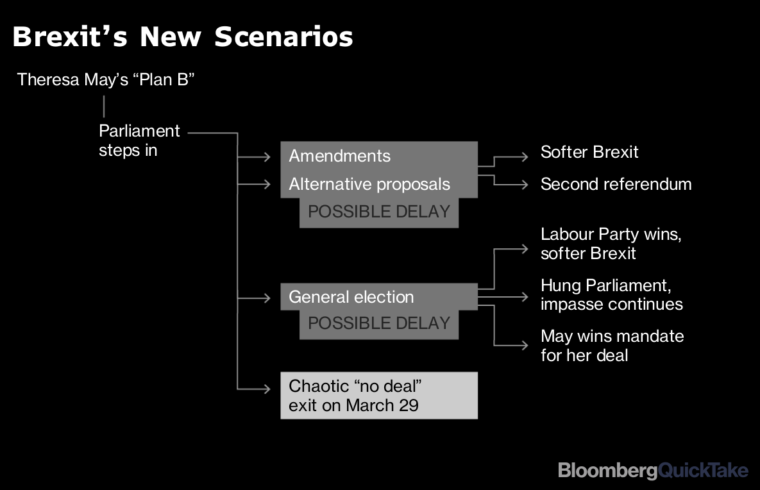Just as the Brexit saga was about to come to an end, it got more dramatic and a lot more confusing. An already uncertain process was thrown into disarray when the U.K. Parliament rejected, by a historic 230-vote margin, the divorce deal that Prime Minister Theresa May had spent 18 months negotiating with the European Union. That has left Britain facing a March 29 exit deadline that may or may not be extended, growing panic among businesses scrambling to prepare for a possible “no-deal” exit, an exasperated EU trying to move on, and calls to redefine Brexit or abandon it altogether.
1. Where’s this drama going?
After her plan was
routed in Parliament on Jan. 15, May offered to hold cross-party talks to find a compromise. That didn’t yield anything. She’s pushing for tweaks to the deal with the EU — but there’s no sign of progress there, either. Some
veteran lawmakers are threatening to take the whole process out of her hands. With a showdown in Parliament looming on Jan. 29, members are proposing amendments and bills to extend the deadline, rewrite the deal or even engineer a second referendum.
2. Aren’t they cutting it a bit close?
Yes. That’s why a lot of people are starting to think an extension to the March 29 deadline is likely. It’s been openly discussed on the EU side, and in
private by U.K. officials. May is sticking to the line that the country will leave on schedule — though she stops well short of ruling out an extension. Currency traders
are also betting the exit will be delayed. The U.K. would have to ask for an extension and get EU countries to unanimously agree, which they probably would.

3. Why did May’s deal fail?
There was opposition on all sides: from pro-Brexit hardliners in May’s Conservative Party, pro-EU Conservatives, the Northern Irish party that props up her government and nearly all of the opposition Labour Party. Their main objection was to the guarantees included in the deal to make sure a
new physical border doesn’t emerge between Northern Ireland, which is part of the U.K., and the Republic of Ireland, which will remain in the EU. Critics say the pledges — which constitute what’s known as the
“backstop” — risk binding the U.K. to EU rules forever. They argue that May caved in to the EU and betrayed the electorate’s call to regain sovereignty, while treating Northern Ireland differently to the rest of the country, an unacceptable outcome for the region’s Democratic Unionist Party.
Read more: Why Ireland’s Border Commands Its Own Brexit Backstop
4. What did the rest of the deal look like?
Alongside the divorce treaty was a non-binding
political declaration on what future ties between Britain and the bloc should look like. It was vaguely worded, an intentional move designed to help May get the deal through a divided Parliament. But that vagueness became a liability as lawmakers complained May was asking them to sign off on a “blind Brexit” — a departure from the EU without a clear sense of what the future holds. A permanent deal on economic and trading ties was meant to be thrashed out during the 21-month transition, or grace period, that starts the day Britain leaves (but only if the divorce deal is ratified).
5. Will the EU offer May a better deal?
EU leaders have repeatedly said that the withdrawal agreement cannot be changed. But they are open to re-writing the political declaration. So if members of Parliament do seize control of the process, as expected, then the House of Commons could end up voting to maintain much closer ties to the bloc than May’s plan envisaged. The EU has always hoped to keep close trading ties — and to keep the U.K. abiding by the bloc’s rules as a quid pro quo. Re-writing the political declaration won’t address the issue of the Irish backstop, though it may make it less likely that the much-loathed measure would ever come into effect.
6. Can the whole thing be called off?
Yes. But there are some huge obstacles. For now, there isn’t a majority in Parliament for a second referendum, though that could change. Labour leader Jeremy Corbyn says it’s an option that should be voted on in Parliament, but he would still prefer to trigger a general election. If Corbyn backs a re-run there’s a fair chance it will go ahead. About 10 Conservatives have already come out in favor of going back to the people, as have the smaller opposition parties. Polls indicate that support among voters is now more strongly in favor of remaining in the EU than leaving, but that was true before the first referendum too. Leave won in 2016 with 52 percent of the vote.
7. What’s a no-deal Brexit?
There’s a chance that if May’s deal is voted down, Britain would crash out of the bloc on March 29 with
no agreement or grace period. That would leave the U.K. with no legal arrangements to smooth trade and other transactions with its neighbors, snarling cross-border commerce and freezing markets. Bottlenecks could bring shortages of everything from food to drugs to manufacturing components. But the no-deal scenario is getting less likely as Parliament becomes increasingly assertive in trying to prevent it. Lawmakers are using amendments to legislation and cross-party cooperation to try to bind the hands of the government and make it impossible for May to lead the country out of the bloc without a deal.
8. How is the uncertainty affecting global business?
Companies operating in Britain have bemoaned the government’s lack of clarity over Brexit’s impact, warning that unanswered questions about everything from trade policy to immigration laws are throttling hiring and investment decisions. Manufacturers who import or export goods now don’t know what will happen after March 29. The prospect of Brexit has already prompted global banks to move
operations, assets and people to Frankfurt, Paris and other cities. Manufacturers and broadcasters have also
started moving facilities, while companies are
stockpiling to prepare for the worst.
The Reference Shelf











